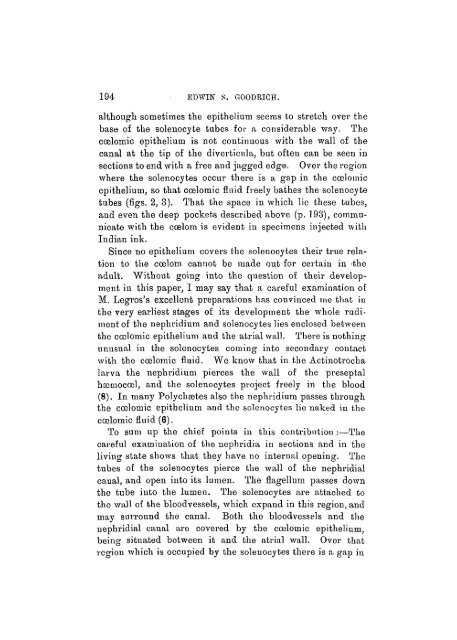On the Structure of the Excretory Organs of Amphioxus. Part 2.—The ...
On the Structure of the Excretory Organs of Amphioxus. Part 2.—The ...
On the Structure of the Excretory Organs of Amphioxus. Part 2.—The ...
Create successful ePaper yourself
Turn your PDF publications into a flip-book with our unique Google optimized e-Paper software.
194 EDWIN S. GOODRICH.<br />
although sometimes <strong>the</strong> epi<strong>the</strong>lium seems to stretch over <strong>the</strong><br />
base <strong>of</strong> <strong>the</strong> solenocyte tubes for a considerable way. The<br />
coelomic epi<strong>the</strong>lium is not continuous with <strong>the</strong> wall <strong>of</strong> <strong>the</strong><br />
canal at <strong>the</strong> tip <strong>of</strong> <strong>the</strong> diverticula, but <strong>of</strong>ten can be seen in<br />
sections to end with a free and jagged edge. Over <strong>the</strong> region<br />
where <strong>the</strong> solenocytes occur <strong>the</strong>re is a gap in <strong>the</strong> coelomic<br />
epi<strong>the</strong>lium, so that coelomic fluid freely ba<strong>the</strong>s <strong>the</strong> solenocyte<br />
tubes (figs. 2, 3). That <strong>the</strong> space in which lie <strong>the</strong>se tubes,<br />
and even <strong>the</strong> deep pockets described above (p. 193), communicate<br />
with <strong>the</strong> coalom is evident in specimens injected with<br />
Indian ink.<br />
Since no epi<strong>the</strong>lium covers <strong>the</strong> solenocytes <strong>the</strong>ir true relation<br />
to <strong>the</strong> coalom cannot be made out for certain in •<strong>the</strong><br />
adult. Without going into <strong>the</strong> question <strong>of</strong> <strong>the</strong>ir development<br />
in this paper, I may say that a careful examination <strong>of</strong><br />
M. Legros's excellent preparations has convinced me that in<br />
<strong>the</strong> very earliest stages <strong>of</strong> its development <strong>the</strong> whole rudiment<br />
<strong>of</strong> <strong>the</strong> nephridium and solenocytes lies enclosed between<br />
<strong>the</strong> coelomic epi<strong>the</strong>lium and <strong>the</strong> atrial wall. There is nothing<br />
unusual in <strong>the</strong> solenocytes coming into secondary contact<br />
with <strong>the</strong> coelomic fluid. We know that in <strong>the</strong> Actinotrocha<br />
larva <strong>the</strong> nephridium pierces <strong>the</strong> wall <strong>of</strong> <strong>the</strong> preseptal<br />
htomocoel, and <strong>the</strong> solenocytes project freely in <strong>the</strong> blood<br />
(8). In many Polychsetes also <strong>the</strong> nephridium passes through<br />
<strong>the</strong> coelomic epi<strong>the</strong>lium and <strong>the</strong> solenocytes lie naked in <strong>the</strong><br />
coelomic fluid (6).<br />
To sum up <strong>the</strong> chieE points in this contribution :—The<br />
careful examination <strong>of</strong> <strong>the</strong> nephridia in sections and in <strong>the</strong><br />
living state shows that <strong>the</strong>y have no internal opening. The<br />
tubes <strong>of</strong> <strong>the</strong> solenocytes pierce <strong>the</strong> wall <strong>of</strong> <strong>the</strong> nephridial<br />
canal, and open into its lumen. The flagellum passes down<br />
<strong>the</strong> tube into <strong>the</strong> lumen. The solenocytes are attached to<br />
<strong>the</strong> wall <strong>of</strong> <strong>the</strong> bloodvessels, which expand in this region, and<br />
may surround <strong>the</strong> canal. Both <strong>the</strong> bloodvessels and <strong>the</strong><br />
nephridial canal are covered by <strong>the</strong> coelomic epi<strong>the</strong>lium,<br />
being situated between it and <strong>the</strong> atrial wall. Over that<br />
region which is occupied by <strong>the</strong> solenocytes <strong>the</strong>re is a gap in

















